When ‘Something’ Looks the Same As ‘Nothing’: Strabismus, Leukocoria and Childhood Eye Cancer
Sunday May 12, 2019
Strabismus (turned eye) and leukocoria (white pupil), the most common signs of retinoblastoma, can also occur in healthy eyes. Sandra Staffieri, Retinoblastoma Care Co-ordinator at the Royal Children’s Hospital, Melbourne, examines both and answers the key question – when should parents and doctors be concerned?
“If most solid tumors of childhood are indeed correctly attributable to mutations in germ and/or somatic cells…then childhood cancers cannot be prevented…the main effort against childhood cancer must be that of early diagnosis and treatment”
Can you tell which two of these four children has cancer?
Read on for the answers!
You know how you can remember important moments in your life, when the “penny dropped” and you suddenly made an important realisation? Such is my relationship with the early signs of retinoblastoma. Despite working in the field for 20 years, I had never really given any thought to the journey parents had taken before receiving the life-changing news that their precious child had eye cancer. It was October 2012, high above the treetops at the inaugural One Retinoblastoma World meeting in London that I was first faced with the concept of delayed diagnosis of retinoblastoma and the signs parents noticed that prompted taking their child to see a doctor.
Upon my return to Melbourne, I decided to explore this further. I set about interviewing parents of children diagnosed with retinoblastoma who I had looked after in the past. I had heard their stories before, but in the context of taking a medical history. I had never REALLY considered the often convoluted or delayed process they had experienced – either because they simply did not know any different or their doctor didn’t consider their concerns problematic. I was both floored and horrified that delayed diagnosis occurred in my backyard too.
Despite an enviable health system and local access to all the treatments available, equivalent to some of the best or largest treatment centres in the world, we still had children presenting later than was desirable to achieve the best outcomes. Sure, our survival rate was second to none at 98%, but for children with only one affected eye, 92% of the time, we were still removing their affected eye because no other treatment was safe if our goal was to save the child’s life.
This realisation, that maybe parents didn’t know a turned eye or a white pupil may be important signs of an eye problem, set me on a path to completing my PhD. So, there you have it, I have spent the last 4 years of my life thinking about retinoblastoma, the signs parents might observe, why these signs might be missed and importantly, how we might get the message systematically to all parents.
Common Signs for a Rare Disease
The earliest signs of retinoblastoma are a crossed/turned/lazy eye (strabismus), or a white pupil (leukocoria) – seen with either the naked eye or in a photograph. The problem is, not every white pupil or turned eye is caused by retinoblastoma. Either of these signs could be absolutely nothing, and most of the time it is, but sometimes, it is ‘something’. This is compounded by the fact that retinoblastoma is rare – unless of course it affects someone you know.
To understand why these signs can be readily missed or dismissed, read on…
What’s With the White Pupil?
Despite the passage of time, parents still describe the characteristic white pupil seen in retinoblastoma in much the same way: as a “glow”, “hologram”, “just like a cat’s eye” or “the eye is shining”. It may not be visible with the naked eye all the time, but rather a fleeting observation in certain lighting or from a particular angle. The size and position of the tumour within the eye will influence how or when it will be seen.
“I’ve seen it in lots of animal photos – it must be the same”
That’s right, white pupils are commonly seen in animals, and in animals it is perfectly normal. This is because they have an extra layer of tissue in their eye that reflects light to help them see (and hunt) in the dark. SO – very normal for animals, but not so normal for humans as our eyes are not the same. In fact, one of the most common descriptions parents give describing a white pupil caused by retinoblastoma is “just like a cat’s eye”, which is where the term: “cat’s eye reflex” comes from.
Perhaps because we are used to seeing the glow so much in animals, it is easy to disregard when it is seen in humans?
“I see white pupils in photos taken with a smartphone”
Seeing white pupils in photos taken with smartphones is also very common. Although new models are trying to reduce this effect, it is still a frequent problem. When we see something often and know the eyes are actually healthy or ‘normal’, it is easy to think any image with the same or similar appearance is normal too. At a time when we are trying to raise awareness of white pupils, we are becoming desensitised to it as we see it so frequently and dismiss it.
Retinoblastoma specialists from around the world are photographed at an international meeting. The smartphone captures optic nerve reflex in every member of the group.
“Isn’t it just the flash of the camera?”
You will be familiar with seeing ‘red eyes’ in photographs. This occurs when the light from the camera flash is reflected back from the healthy light-sensing tissues and blood vessels inside the eye. In the area of the optic nerve there are fewer fine blood vessels, so at certain angles, light may bounce off the optic nerve, giving the appearance of a white pupil. This can be very common, and in this instance, it is just the camera flash.
If a retinoblastoma is in the eye, the light from the camera flash will bounce off the white or yellow tumour within the eye and give exactly the same appearance. This is very rare because retinoblastoma is rare.
A) Nothing
B) Something
Both of these photos show a child with a white pupil in their left eye.
In picture A, the child was found to have a completely normal left eye, the white pupil being caused by the camera flash bouncing off the optic nerve. However, the child in picture B, had a large retinoblastoma that required removal of her eye.
Both of these photos look the same, yet ‘nothing’ looks the same as ‘something’. The only way to tell is to retake the photographs from different angles (not with a smartphone but with a regular camera with red-eye reduction turned OFF) or to have an eye examination by someone who is used to examining children’s eyes. You should take your photos with you to the examination to help explain what you are seeing.
WE C Hope provides simple instructions for the PhotoRED technique to retake your photos. Use this technique regularly to check for normal red reflex in your children.
White reflex often does not appear in every photograph. This depends on the size, number and location of tumours, and the angle at which the flash enters the eye. The child in these three photos was diagnosed with cancer in both eyes.
Straightforward Squint or Sinister Sign?
Many words can be used to describe a turned eye. “Lazy eye”, “wandering eye”, “cast eye”, “squint”, “crossed-eye” but the medical term is ‘strabismus’. The most confusing of all these terms is “lazy eye” as it is used interchangeably to mean different things. It may refer to ‘strabismus’, or it may be used to refer to an eye that has ‘poor vision’ or sometimes when the eyelid ‘droops’ or appears ‘lazy’ – probably because it isn’t opened up enough! It is no wander there is confusion when we talk about strabismus since in lay terms, we don’t have one single, consistent word to describe it.
On top of that, a health practitioner using the word ‘lazy’ might infer that the eye will get ‘stronger’ or ‘better’ by itself. True strabismus does not get better by itself…read on if you want to know more.
“Which way can it go and how big does it need to be?”
Usually, the two eyes should point in the same direction and move together to follow an object of interest. When strabismus is present, the affected eye will usually wander inwards or outwards but can also go up or down instead. Strabismus may be observed some or all of the time. The turn may be obvious only at certain angles or even only in a photo, which makes it very confusing or difficult for a parent to decide if they should see a health care practitioner.
All eye turns are different and can be caused by different things. Irrespective of the direction of the strabismus, how far in, out, up or down it goes, or even how often you see it, the child’s eyes should be assessed by someone experienced in doing so.
Outward turn (exotropia)
Upward turn (hypertropia)
Inward turn (esotropia)
The three children pictured above were all diagnosed with retinoblastoma. A downward turn (hypotropia) is harder to photograph and often goes unnoticed because the eyelid masks it – eye turns are most noticeable due to an imbalance of visible sclera (white of the eye).
“All babies eyes turn! Won’t they just grow out of it?”
What makes strabismus complicated is that it can be an optical illusion, occur as a normal part of early development, or most of the time not be caused by retinoblastoma at all.
For a very short period in a baby’s life, strabismus that comes and goes can be normal. This usually occurs briefly as the baby’s brain develops all the connections needed to use the information from both eyes at the same time. By the time baby is 4 months old however, their eyes should be straight all the time and working together. Strabismus in a child beyond this age, even if it comes and goes, should be assessed by someone who is used to examining young children.
The appearance of an eye turn can frequently be an optical illusion caused by the baby’s wide nasal bridge. This wide fold of skin hides the white of the eye and can give the impression the eye is turning in. As their face grows, the wide fold of skin narrows, and the eyes look straight.
This is probably why we often hear the advice: “Don’t worry, he’ll grow out of it”
“Why does retinoblastoma cause a turned eye?”
A turned eye can either CAUSE poor vision or BE CAUSED by poor vision.
For most children, a turned eye will cause poor vision which still makes it very important to diagnose and treat early whilst their vision is still developing.
In children with retinoblastoma, once the tumour in the eye interferes with their vision, this can cause the eye to wander. Often, parents will describe seeing strabismus long before the white pupil, but because we are ‘trained’ or ‘conditioned’ to believe strabismus is normal, it is readily dismissed.
As with the white pupil in photographs, there is no way to distinguish between strabismus that is caused by retinoblastoma and one that is not. As with white pupils, the only way to be sure is for the child to be assessed by someone who is used to examining children’s eyes.
C) Something
D) Nothing
Both of these photos show a child with a large inward turning left eye.
In picture C – the child was found to have retinoblastoma in the left eye. However, the child in picture D, had an otherwise normal eye. His strabismus was due to a muscle problem that required an operation.
Again, the point is their strabismus looks exactly the same, and only an eye examination can actually determine the underlying cause.
Sometimes strabismus runs in families. That is, either parent or other siblings can have strabismus too. So, because it is ‘familiar’ it is easy to ignore and ‘wait’, thinking there is no rush for any assessment or treatment. But no two children are the same – even in the same family! Every child with strabismus should promptly have a full eye full eye assessment, including an examination inside the eye.
In fact, in 1969 Dr Robert Ellsworth, a leading expert in retinoblastoma, even suggested “it is not a bad idea to consider that every child with strabismus has retinoblastoma until proven otherwise.” I can understand why he would think that, and his wise words still hold today.
One Big Problem
The biggest problem for retinoblastoma early diagnosis is that it is a rare disease whose early signs are not only common, but often mean nothing or nothing serious. Thus, in raising awareness of strabismus and white pupils as signs of retinoblastoma, there is a fine balance to be struck between being alert without being alarmed, and vigilant without being paranoid.
For Every Problem There Must Be A Solution!
“I wouldn’t be worried about that – it’s just the flash; I’ve never heard about a white pupil. You’d think you would have if it was important?”
“I wouldn’t see a turned eye and think ‘Oh, that is an emergency…It doesn’t seem like an emergency, it seems like a developmental problem that you can get addressed in due time.”
It is clear from parent interviews that there is a lack of knowledge about the importance of the early signs of retinoblastoma. But this lack of knowledge is because we as health professionals haven’t told them.
“You don’t know, what you don’t know!”
Parents or caregivers are usually the first to notice a problem with their child. It is our responsibility as health practitioners to provide relevant and useful information to parents in a way that can be understood, and often enough for it to be remembered. There are many ways that providing information can be achieved. In this new age of information overload via the internet and social media, we may feel overwhelmed and start to ignore information that is actually important.
Solving the problem of awareness is neither easy nor straightforward. Indeed, raising awareness among health practitioners is also very important, and perhaps even more so. There are many instances where parents have reported a problem only for it to be dismissed without an adequate examination or referral.
Empowering parents with information to recognise and respond to observing strabismus and white pupils, and providing strategies and resources to navigate their way when these signs are seen, is critical to educating the health practitioner they visit. Combined, we may start to see earlier diagnosis of retinoblastoma and better outcomes for all.
All you need to remember: “Something looks the same as nothing. If in doubt, check it out!”
White reflex & no red reflex
White reflex & strabismus
Strabismus
If you see strabismus or a white reflex in either of your child’s eyes, separately or combined (as shown above), request an eye exam. Also if red reflex is naturally absent in flash photos taken with your camera’s Red Eye Reduction setting turned OFF, as in the first photo.
Use the PhotoRED technique to check for normal red-reflex. Do not use a smartphone as the cameras are not reliable for checking red-reflex (as seen to the right). Take your photos to the appointment to help explain to the doctor what you see.
Smartphones are unreliable to check for normal red-reflex. Use a regular camera with Red-Eye Reduction turned OFF.
About the Author
Sandra Staffieri is a Clinical and Research Orthoptist at the Centre for Eye Research Australia (CERA). Working at the Royal Children’s Hospital, Victoria (RCH) and in private clinics, she has over 30 years’ experience in children’s eye health and disease.
Over more than 25 years, Sandra has developed the unique role of Retinoblastoma Care Co-ordinator at the RCH. Supported by a National Health and Medical Research Council Public Health Post-graduate scholarship, Sandra recently completed her PhD on delayed diagnosis of retinoblastoma. Her prime focus was to develop and evaluate an information pamphlet for new parents to raise awareness of the important signs of childhood eye disease – especially strabismus and leukocoria in the hope this could lead to earlier diagnosis of retinoblastoma.

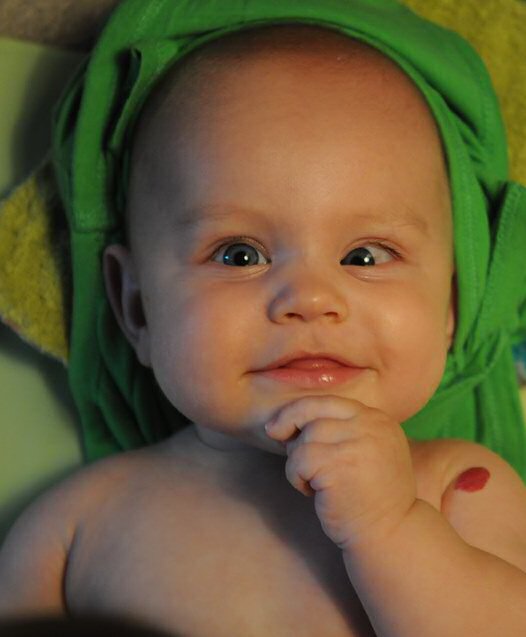
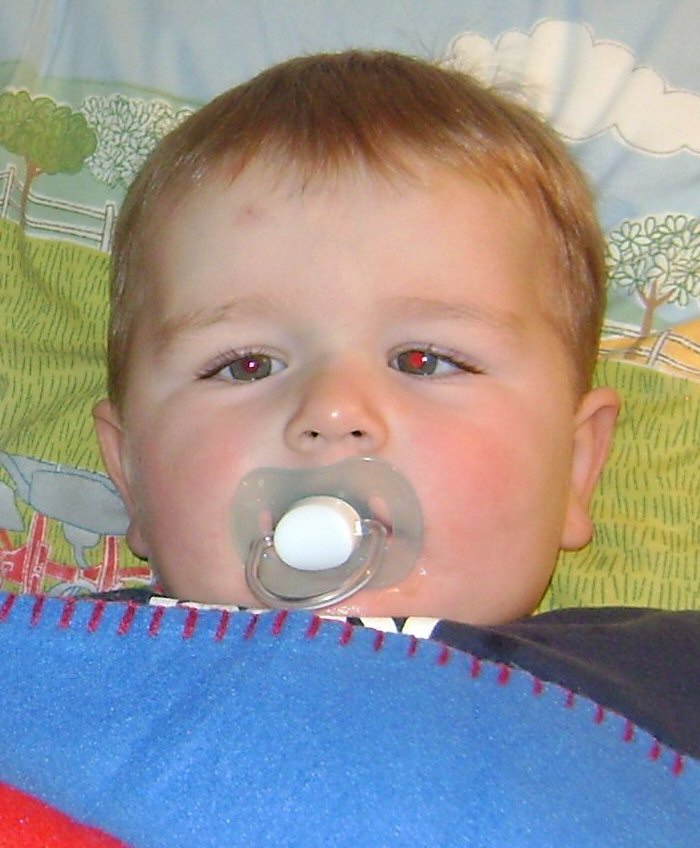

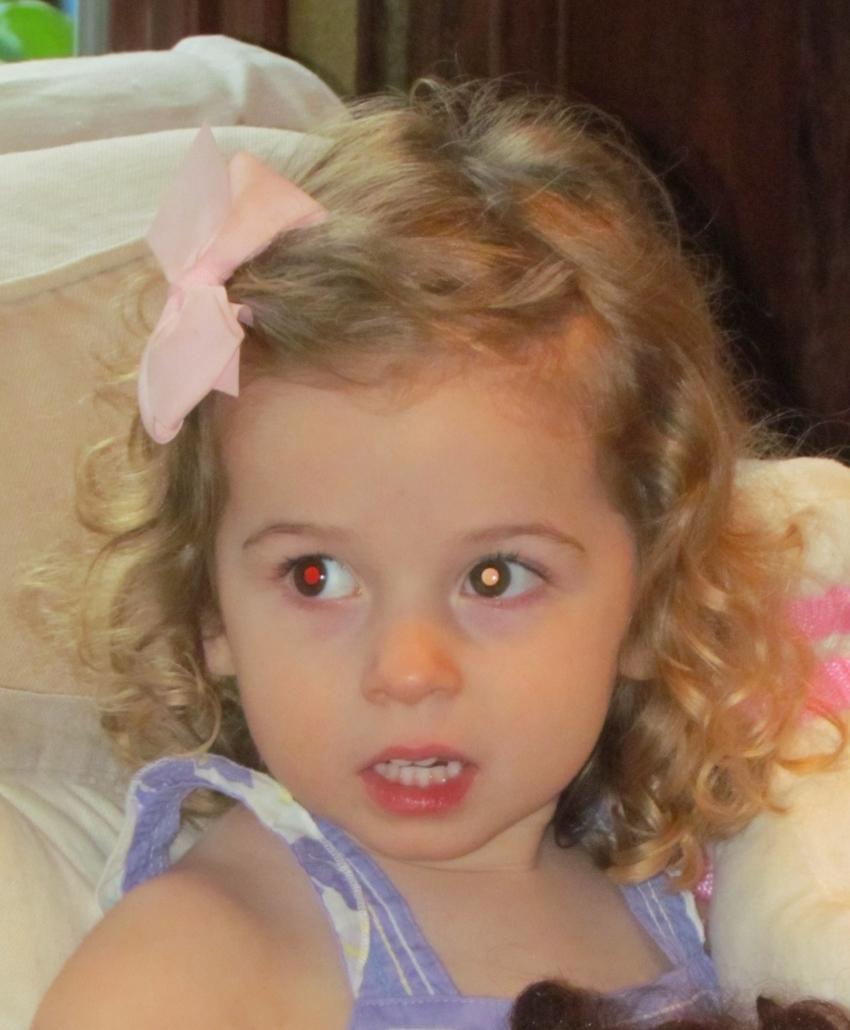





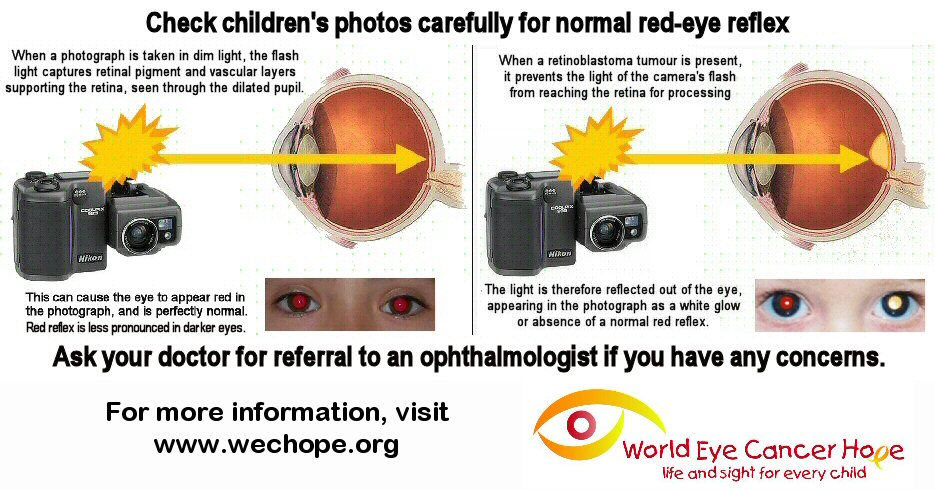







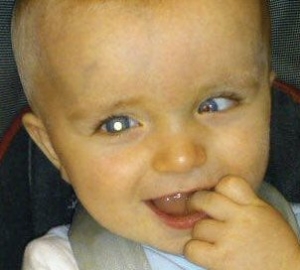





Share this entry